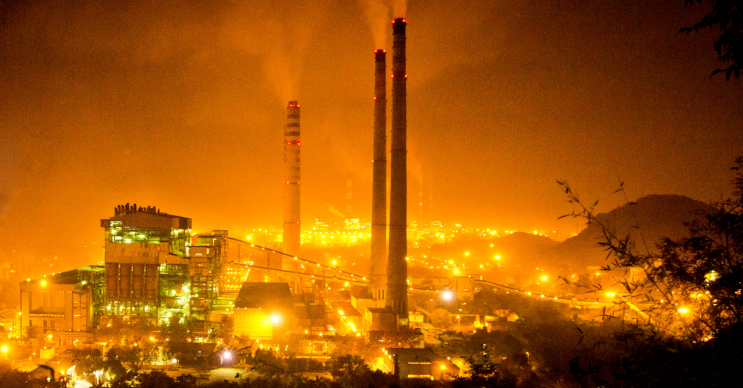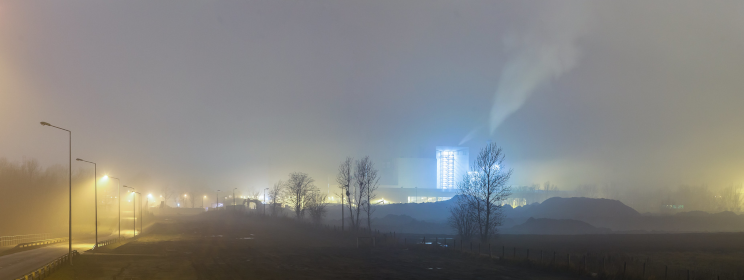Archives
June 2024
Categories
All
|
Back to Blog
Light Pollution and Climate Change2/1/2024 Image credit: International Accountability Project / CC BY-NC 2.0 1387 words / 6-minute read Summary: Light pollution represents wasted electricity, which in turn means millions of tons of greenhouse gases added to the atmosphere every year. Even when we use energy-efficient outdoor lighting, the world's never-ending tendency to consume more resources causes increasing emissions of climate-warming carbon. Reducing our use of outdoor artificial light at night can help solve both the problems of light pollution and global climate change. In January 2024 we wrote about a big idea that follows from U.S. environmental policy history: the idea of a "Clean Night Skies Act". In a similar vein, many people are looking toward policy models to address other big environmental problems like global climate change. That, too, intersects with light pollution, energy production and consumption, and environmental policy. In this month's post we focus on the ways in which light pollution is an influence on climate change — and what we can do about it. Wasted light is wasted energyWe light the world at night in remarkably inefficient ways. Think about the typical street light, for example. From source to destination, where does the light go? More importantly, how much of the light reaches the intended target? Some loss occurs within the light fitting or fixture itself. Much of the light may not reach the target, instead illuminating things and places where it is neither wanted nor needed. Often the light travels upward into the night sky, either directly from the source or after reflecting from a surface. And much of the world's outdoor lighting is operated at times when no people are around to make use of it. The result of all these effects is that very little light actually makes it to the viewer's eye. By one estimate, less than one photon, or particle of light, out of move than 22 million reflected from a surface is actually useful for human vision at night. [1] That means that we generate considerably more light at night than ever reaches viewers' eyes. The resulting sense of waste is staggering. In turn, it means that we use a lot of energy to power all that lighting. DarkSky International estimates that the world spends at least $50 billion each year to produce light at night that escapes directly to space. [2] In the U.S. alone, outdoor lighting consumes some 380 terawatt-hours of electricity per year. That's enough to power 35 million homes for one year. And well under 1% of that energy produces light that achieves its intended effect. All that wasted energy comes at more than an economic cost. The world produces over 60% of its electricity by burning fossil fuels. [3] If even 1% of that production takes the form of wasted light at night, that's still 146 million tons of carbon dioxide emitted into the atmosphere every year. [4] Although renewable energy sources make up an increasing share of total world electricity production, they're not yet enough to offset these emissions. Human-caused carbon emissions continue putting more heat energy into our atmosphere with increasingly dire consequences. There's no escaping the conclusion: light pollution is making the problem of climate change worse. The 'greenwashing' of energy-efficient lighting?When confronted with this news, many people think that it can't be as bad as it sounds. After all, we live in the era of very energy-efficient light sources like light-emitting diodes (LEDs). And at a certain level, that's true: LED and other kinds of 'solid-state lighting' are very efficient. In fact, many LED lighting products routinely achieve efficiencies about ten times higher than earlier technologies like incandescent filament lamps. If LED replaced those old lamps on a one-for-one basis, we would expect global energy use from lighting to start coming down. In 2017 the United Nations Environmental Programme estimated that a transition to energy-efficient lighting would reduce global electricity demand for lighting by 30–40% by 2030. [5] But that doesn't seem to have happened yet. In fact, it may be that there has been no energy benefit from LED lighting at all. Along with the rapid adoption of LED for its perceived energy savings came a vast decrease in the cost of LED lighting equipment. The price of that equipment fell by a factor of 15 during the decade of the 2010s, [6] making LED suddenly very affordable. As the up-front cost of replacing earlier technology with LED declined, the "payback time" through energy savings decreased. Many governments felt they couldn't turn down the opportunity LED presented. This is an example of what economists refer to as "elastic demand": as the price of something drops, demand for it tends to goes up. We experience this in everyday situations. For instance, when the price of gasoline/petrol goes down, do you drive less or more? In this case, plummeting LED prices seems to have led to strong elastic demand for lighting products. In the first half of the 2010s, satellite measurements of light at night revealed steady increases over much of the world. Those increases mirrored changes in global economic output during the same period. The authors of a 2017 study on this concluded that "the results presented here are inconsistent with the hypothesis of large reductions in global energy consumption for outdoor lighting because of the introduction of solid-state lighting." [7] It is possible that there has been no net environmental benefit due to the introduction of highly energy-efficient lighting. If this is true, then then situation becomes circular. The very factor that influenced the rush to adopt this technology was not realized in the end. If anything, the available evidence suggests that LED encouraged the use of more light at night. It seems to have resulted in installing lighting in places it where didn't previously exist and adding more to places where it did. One way to look at the outcome it is that the world traded one environmental problem for another. Air and light pollution over Poznań, Poland, in December 2016. Credit: Flickr/Sakuto, CC BY-NC 2.0. Reducing light pollution means real energy savingsMaybe we have the notion of "efficiency" all wrong. Lighting scientists and engineers, and policy makers following their advice, focused on raw energy consumption. But their obsession with "lumens per watt" seems to have led us down the wrong path. Worse, given certain realities in terms of human behavior, LED may have not achieved its stated goals at all. It made light cheap, and people consumed more of it without attention to its negative consequences. Real energy savings, and real carbon emissions reductions, come from cutting consumption of light at night. The Five Principles for Responsible Outdoor Lighting embody this idea:
Adherence to these principles has the immediate result of eliminating pure waste. More savings come from lowering light levels to safe thresholds and not exceeding them. In addition, the use of adaptive lighting controls tailors availability of light to meet needs, extinguishing it otherwise. The way to turn the corner on the problem of light pollution fueling climate change is to encourage mindful application of outdoor lighting. This model has the effect of reducing both energy consumption and light pollution. In turn, reducing electricity use lowers costs and encourages resilience in the face of climate change. The good news is that there is no down side to this approach. It does not entail giving up anything to achieve the stated benefits. Illumination levels remain adequate, preserving public safety. Governments and end users realize the benefits of energy and cost savings. The nighttime environment suffers less from light pollution. And in world that desperately needs a "win" on environmental issues, reducing the impact of light pollution may be the easiest win of all to secure. References[1] Bará, S. (2022). A note on the overall efficiency of outdoor lighting systems. Zenodo. https://doi.org/10.5281/ZENODO.6588229
[2] DarkSky International. (2022 August 2). "Light is Energy: Estimating the Impact of Light Pollution on Climate Change". https://darksky.org/news/light-is-energy-estimating-the-impact-of-light-pollution-on-climate-change/ [3] International Energy Agency. (n.d.) "World Energy Balances: Overview" https://www.iea.org/reports/world-energy-balances-overview/world [4] International Energy Agency. (March 2023) "CO2 Emissions in 2022" https://www.iea.org/reports/co2-emissions-in-2022 [5] United Nations Environmental Programme. (2017 October 2). Accelerating the global adoption of energy efficient lighting. https://www.unep.org/resources/publication/accelerating-global-adoption-energy-efficient-lighting [6] Freeing Energy. (n.d.) "Energy Fact – Cost of LED lighting dropped 15-times as volumes increased" https://www.freeingenergy.com/facts/led-bulb-light-cost-price-historical-decline-g213/ [7] Kyba, C., et al. (2017). Artificially lit surface of Earth at night increasing in radiance and extent. Science Advances (Vol. 3, Issue 11). https://doi.org/10.1126/sciadv.1701528
0 Comments
Read More
|
 RSS Feed
RSS Feed


